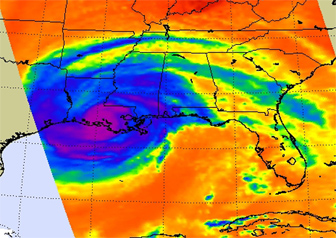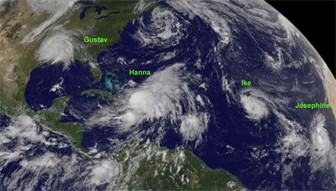Scientists forecast 4 Atlantic hurricanes in September
Scientists forecast 4 Atlantic hurricanes in September
mongabay.com
September 2, 2008
|
|
Prominent hurricane researchers are forecasting five tropical storms in the Atlantic for September, including four hurricanes. Two of these are expected to be “major” — category 3 or greater.
Retired Colorado State University climatologist William Gray and Philip J. Klotzbach, who has taken over Gray’s role as lead hurricane forecaster, estimate that Atlantic storms in September will be twice as active as normal.
The tropical storm tally includes Tropical Storm Ike, which formed Monday, and Tropical Storm Josephine, which formed Tuesday. Hanna, which attained hurricane strength on Monday, counts toward the four hurricanes forecast for the month, but not the tropical storm estimate.
 This infrared image of Gustav was created by data from the Atmospheric Infrared Sounder (AIRS), an instrument that flies aboard NASA’s Aqua satellite. It was created on Monday, Sept. 1 at 18:59 UTC (2:59 p.m. EDT). NASA JPL  Tropical Depression Ten formed in the early morning hours of September 2nd and by the afternoon it strengthened into Tropical Storm Josephine. That means that there were four tropical cyclones active in the Atlantic Ocean basin on Tuesday, September 2nd. This satellite image was captured on September 2 at 17:45 UTC (1:45 p.m. EDT) from the Geostationary Operational Environmental Satellites (GOES-11 and GOES-12). In the image, Tropical Depression Gustav is on the far left over northwest Texas; Tropical Storm Hanna is located to the right of Gustav, currently over the southern Bahamas; Tropical Storm Ike follows to the right in open ocean; and Tropical Storm Josephine is off the African coast, far right. Caption credit: Rob Gutro/Goddard Space Flight Center |
The researchers note that the 2008 hurricane season has already been very active, with Hurricane Bertha (July 2008), the longest-lived July storm on record at more than 17 days; Hurricane Dolly, which made landfall in south Texas as a Category 2 hurricane and caused 1.5 billion dollars in damage; and Gustav, which made landfall in Louisiana on Labor Day, causing flooding.
Overall, Gray and Klotzbach predict an above average hurricane season in the Atlantic due to above average ocean temperatures, neutral El Niño-Southern Oscialltion (ENSO) conditions, and low sea level pressure values. The researchers expect 17 named storms and 9 hurricanes, including 5 “major” hurricanes, to form during the 2008 season.
Gray has long argued that the recent up tick in hurricane activity is due to natural cycles rather than climate change, a position contested by other climate scientists who say that climate linked warmer ocean temperatures are triggering stronger and more frequent storms.